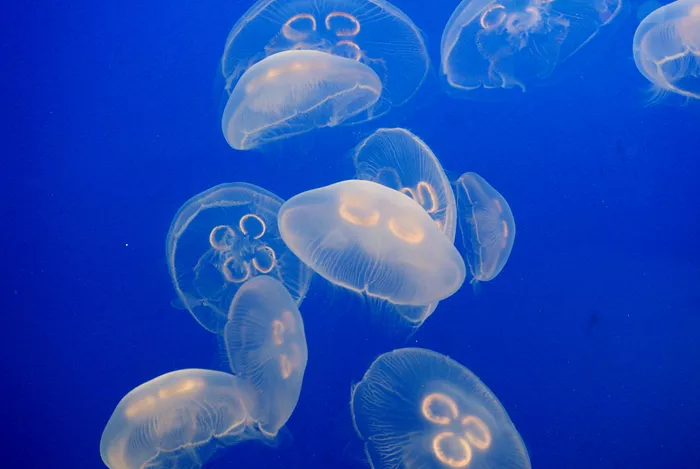Moon jellyfish, scientifically known as Aurelia aurita, are fascinating creatures that inhabit oceans worldwide. Known for their translucent bodies and gentle movements, these jellyfish are not only visually captivating but also play a significant role in marine ecosystems. This article explores 10 amazing facts about moon jellyfish, shedding light on their biology, behavior, and ecological importance.
1. Unique Anatomy
Moon jellyfish are primarily composed of water, with about 95% of their body weight being water. Their bodies are gelatinous and can reach up to 12 inches (30 cm) in diameter. The bell-shaped dome is typically translucent with a bluish hue and features four distinct horseshoe-shaped gonads visible through the bell. This unique anatomy allows them to float effortlessly in the water.
2. Habitat and Distribution
Moon jellyfish can be found in temperate and tropical waters around the globe, commonly near coastlines and in shallow bays. They thrive in a range of temperatures but prefer waters between 45°F (7°C) and 70°F (21°C). These jellyfish are often seen during the summer months when they congregate in large blooms.
3. Feeding Habits
As carnivores, moon jellyfish primarily feed on zooplankton, small fish larvae, and other microscopic organisms. They capture prey using their short tentacles lined with stinging cells called nematocysts. When food is scarce, moon jellies can shrink to conserve energy, demonstrating their remarkable adaptability.
4. Life Cycle
The life cycle of moon jellyfish includes both sexual and asexual reproduction. They begin as small polyps attached to surfaces like rocks or docks. After a period of growth, these polyps undergo a process called strobilation, where they produce free-swimming medusae (the adult form). This dual life cycle allows them to thrive in various environments.
5. Minimal Threat to Humans
Unlike some jellyfish species known for their painful stings, moon jellyfish have a mild sting that is generally harmless to humans. Most people experience little to no reaction upon contact with their tentacles, making them one of the least dangerous jellyfish species.
6. Ecological Role
Moon jellyfish play an essential role in marine ecosystems as both predators and prey. They help control zooplankton populations while serving as food for various marine animals, including sea turtles, sunfish, and certain fish species. Their presence indicates the health of marine environments.
7. Blooms and Environmental Indicators
Moon jellyfish are known for their large blooms, which can occur under favorable conditions such as warm water temperatures and abundant food sources. These blooms can sometimes be detrimental to local fisheries by clogging nets or disrupting ecosystems. Additionally, an increase in moon jelly populations can signal environmental imbalances caused by factors like overfishing or pollution.
8. Adaptations for Survival
Their unique adaptations allow moon jellyfish to survive in various conditions. They can tolerate low oxygen levels and high nutrient loads better than many fish species. This resilience has enabled them to thrive even as ocean health declines due to human activities.
9. Cultural Significance
Moon jellyfish have captured the imagination of artists and filmmakers alike. They have been featured in various forms of media due to their ethereal beauty and mysterious nature. Their presence in aquariums around the world also serves to educate the public about marine life and conservation efforts.
10. On going Research
Scientists continue to study moon jellyfish to understand their biology better and the ecological roles they play in marine environments. Research into their responses to climate change is particularly relevant as ocean temperatures rise and ecosystems shift.
Conclusion
Moon jellyfish are remarkable creatures that embody the beauty and complexity of marine life. Their unique anatomy, feeding habits, and ecological roles make them an essential part of ocean ecosystems. As we continue to explore our oceans and learn more about these fascinating animals, it becomes increasingly important to protect their habitats and ensure the health of our marine environments.
FAQs About Moon Jellyfish
1. What do moon jellyfish eat?
Moon jellyfish primarily feed on zooplankton, small fish larvae, and other microscopic organisms using their tentacles equipped with stinging cells.
2. Are moon jellyfish dangerous to humans?
No, moon jellyfish have a mild sting that is generally harmless to humans; most people experience little or no reaction upon contact.
3. How long do moon jellyfish live?
Moon jellyfish typically have a lifespan of about 8 to 12 months but can vary based on environmental conditions.
4. Where can moon jellyfish be found?
Moon jellyfish inhabit temperate and tropical waters worldwide, often found near coastlines and shallow bays.
5. What is the life cycle of a moon jellyfish?
The life cycle includes both a polyp stage attached to surface
Related topics:


